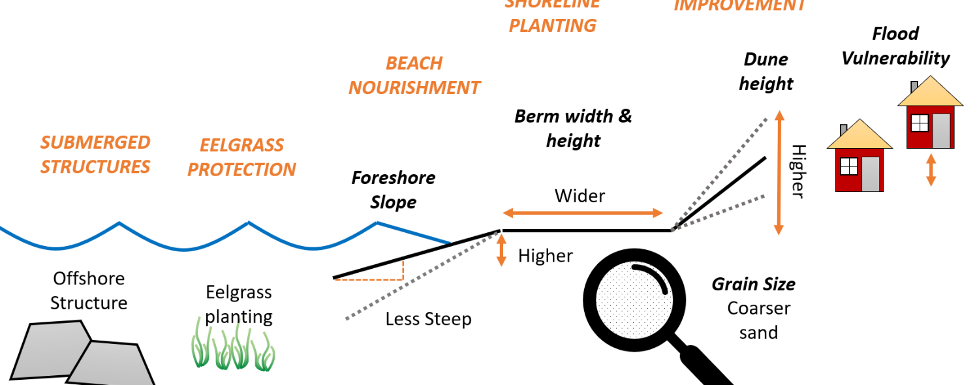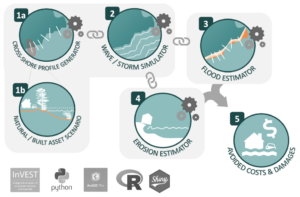Leveraging Natural Assets for Coastal Resilience

Projects Sponsor
From 2018–2021, the Municipal Natural Asset Initiative (MNAI) and the David Suzuki Foundation piloted a project with two communities, the Town of Gibsons, B.C. and Pointe-du-Chêne, N.B. Focusing on nature-based, climate resilient infrastructure, with special emphasis on Canadian shorelines and coastal impacts of climate change, the project produced a Coastal Toolbox. This will allow local governments to do preliminary evaluations of coastal storms and the ensuing erosions and structural damage. MNAI is working hard to help coastal communities identify, prioritise, quantify, and manage key coastal natural assets because when it comes to our shorelines, climate change is no day at the beach.

Pebbles Beach shoreline, Gibsons, BC.
Communities all along Canada’s coasts are facing infrastructure challenges. The structures that people originally built to protect their settlements from storm surges are showing their age, especially as they try to protect against bigger and more frequent storms caused by climate change. Studies show that as climate change heats up the earth’s temperature and melts glaciers, our oceans are expanding, and sea levels are now rising almost twice as fast as they did over the past hundred years. As a result, by the end of the 21st century, millions of people around the world could be forced to relocate and communities could be faced with ongoing high costs to keep building dykes and seawalls as engineered infrastructure fails.
To address these challenges the Municipal Natural Assets Initiative (MNAI), in collaboration with the David Suzuki Foundation, piloted the Managing Natural Assets to Increase Coastal Resilience project.
Working with the Town of Gibsons on British Columbia’s rugged west coast and Pointe-du-Chêne, which is partly protected by the finely sanded Parlee Beach and coastal dunes that slope gently into the Northumberland Strait, the Coastal Resilience pilot project team had two objectives. First off, they wanted to help the participating local governments identify, prioritise, value, and manage key coastal natural assets as part of core local government asset management systems. Second, they also wanted to develop a modelling tool—the Coastal Toolbox or CT—that could enable all coastal communities to quantify, understand, and compare alternative natural asset management solutions.

Project area overview, Gibsons, BC.
As more research is directed towards the concept of natural infrastructure, it’s becoming clear that coastal ecosystems often provide more durable protection than traditional engineered infrastructure approaches. As coastal ecosystems become damaged or destroyed, the protection they provide for coastal communities disappears and the risks associated with coastal flooding increase.
Since 2018, MNAI, alongside the Suzuki Foundation, has been working to quantify the services offered by natural assets, particularly those that provide flood and erosion protection from coastal storms. By the beginning of the Coastal Resilience pilot project, MNAI had already completed stormwater management projects with eleven communities in three provinces and had developed a framework and modelling approach for incorporating natural capital in their municipal asset management.
With the full participation of the Gibsons and Pointe-du-Chêne communities, the MNAI partnership took the first step in developing the Coastal Toolbox. To do this, existing modelling tools were refined to reflect the Canadian context. Ultimately, the finished Coastal Toolbox is a package of ESRI toolboxes built for use in ArcGIS Pro with some supplementary R Shiny functionality (a web application that allows the user to build interactive web apps). The Toolbox calculates wave propagation, beach retreat, and flood levels, and allows users to develop a first-pass estimate of damages from flooding and erosion.
Methods focused on comparing the modelled storm and erosion protection benefits of natural asset management options with and without those management options applied. Both the Coastal Toolbox and the Coastal Resilience pilot projects are brand new in their own rights, stemming from asset management methodologies that MNAI is working to standardise. They are an inaugural step towards innovative, sustainable, climate resilient solutions for other coastal communities.

Tunable model parameters and example applications of the MNAI Coastal InVEST toolbox
MNAI uses methodologies and tools rooted in standard asset management and provides a range of advisory services to help local governments implement them. By adapting current management practices and providing natural asset and coastal asset valuation models, other local governments are better able to recreate the approach and apply it to their own jurisdictions and scale them up or down as needed.
Assessments completed using the Toolbox will help communities decide whether more detailed studies are warranted, aid in community outreach and education, and inform the design, development, and proposal of asset management policies that consider coastal natural assets. The Coastal Toolbox can provide solid insight into financial and environmental impacts of service delivery, giving local governments the power and knowledge to pursue nature-based infrastructure initiatives and more feasible long-term solutions in the face of climate change.
MNAI is working hard to help coastal communities identify, prioritise, quantify, and manage key coastal natural assets because when it comes to our shorelines, climate change is no day at the beach.













